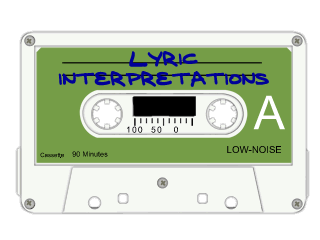Who Did It First? - Nobody: False Music Cliches

Famous figures in history often get parodied or at least stereotyped for things they never said, did, or intended. We now know that George Washington did not have wooden teeth, Napoleon was not particularly short, and Al Gore never boasted that he created the Internet (although he did play a huge role in enabling its roll-out in the United States). In music, a number of these cliches also perpetuate themselves seemingly of their own accord. In many cases, fans and critics of music make up a stereotype, then make jokes about it, then it trickles back to the bands who pick it up and start playing it for laughs, then it starts getting taken seriously.
Isn't that weird? Here's a few rock-associated myths we'd like to debunk:
Druggy hippies The original psychedelic music movement did not particularly use or emphasize drugs. For instance, Frank Zappa hated drugs and spoke out against them at every opportunity (he was also making psychedelic music as a parody, but that's another story). Ditto Captain Beefheart, Jefferson Airplane, and yes, the Grateful Dead. Go ahead, find one Grateful Dead song that advocates the use of drugs! What, you say they got busted for drugs in New Orleans in 1970? Yeah - that was their sound engineer. It was only the fans of psychedelic music who used drugs, and in turn when the second generations of psychedelic music came along, they drew from that.
Heavy metal leather jackets If you check back through rock history, leather jackets did not become associated with heavy metal culture until Judas Priest came along. And Judas Priest was drawing more from biker culture, S&m culture, and gay culture and its connections with underground / counter-culture in general than any current heavy metal fashion statement. Furthermore, Judas Priest was doing it mostly for a goof. Other artists, such as Suzi Quatro and Joan Jett (females, mind you!) would perpetuate leather fashion as a way of making the statement "I'm a rebel and I'm hardcore!" But it actually started with the fan base - bikers, beats, and assorted counterculture misfits were great fans of heavy metal and when you see that many jackets at one concert, it almost becomes a uniform.
Punk rock mohawks Get ready for a jolt: Track down every photograph you can find of any band credited with being one of the pioneers of punk rock: Velvet Underground, Sex Pistols, The Ramones, MC5, The Clash, Patti Smith... wait a minute, none of these people sported mohawks! The closest we get to the stereotypical extreme hairstyle is with spiky hair among the Sex Pistols, and that was mostly unkempt bedhead rather than a deliberate fashion statement. So where the heck did the mohawks come from? The fans, again. Actual punk bands didn't start appearing with mohawks until at least the '80s. For a double-debunking, the actual Mohawk Indian tribe (they inhabited what is now upstate New York) didn't exactly invent the hairstyle - it's been found around the world and throughout history going back to 2000 years ago in Ireland!
Dogs and trucks in country & western music The moldy old joke about how when you play a country & western song backwards, you get your dog and truck back, is another false cliche. Country & western songs that focus on long strings of tragedies don't appear until second and third generation bands. Here again, it was the fans of country & western music who were more likely to have the dogs and trucks. Most country & western songs at the beginning were upbeat and positive.
Iron maidens The band Iron Maiden is itself named after a false cliche! There never was such a torture implement - the coffin-like shape with spikes on the inside meant for pressing and skewering a hapless victim within - deployed. Although the imagery is so powerful that it seems you cannot find an illustration of a Middle-Ages torture chamber without an iron maiden in the corner, it was not invented until the 19th century - by people trying to recreate and reconstruct various devices for museum exhibition, and of course by fiction authors such as Edgar Allen Poe. There were a few Medieval Spanish Inquisition devices which looked like a maiden statue, but historians simply misinterpreted their purpose.
"Scarface"-style gangsta rap "Gangsta" culture within the rap community doesn't show up for many, many years in rap history. First, rap as we know it started out in spoken-word style blues music. '70s disco and funk contains sections of chanted lyrics (see Frankie Smith's "Double Dutch Bus" for an example). When rap proper came along in East Coast cities, it was more upbeat and positive. It had to travel all across the country to the West Coast before it became associated with gangsters via gang-banger culture, which, once again, was more a tendency of the fans than the artists themselves. Finally, a resurgence of popularity of the film Scarface suddenly got all those Al Pacino silk-screen shirts into rap culture.

 A new era for Millennial favorite, Linkin Park
A new era for Millennial favorite, Linkin Park  Anime to watch for the soundtracks… and other reason...
Anime to watch for the soundtracks… and other reason... .jpg) Dolly, we need you
Dolly, we need you  The Stranger Things Effect: How new media is drawing...
The Stranger Things Effect: How new media is drawing...  The most underrated soundtrack of the early 2000s
The most underrated soundtrack of the early 2000s  Buy the Soundtrack, Skip the Movie: Brainscan (1994)
Buy the Soundtrack, Skip the Movie: Brainscan (1994)  Let’s Go to the Hop - Ignore That Door’s Four Bunnie...
Let’s Go to the Hop - Ignore That Door’s Four Bunnie...  Forgotten Weird Music Videos of the Ancient 80s | vol 3
Forgotten Weird Music Videos of the Ancient 80s | vol 3  Forgotten Weird Music Videos of the Ancient 80s | vol 2
Forgotten Weird Music Videos of the Ancient 80s | vol 2  Forgotten Weird Music Videos of the Ancient 80s | vol 1
Forgotten Weird Music Videos of the Ancient 80s | vol 1  Let’s Chase Taylor Swift Rumors
Let’s Chase Taylor Swift Rumors  When the Beatles Touched Off a Movie War
When the Beatles Touched Off a Movie War  When Mike Bloomfield Composed a Soundtrack For Andy ...
When Mike Bloomfield Composed a Soundtrack For Andy ...  Yet Another List of Bad Song Covers
Yet Another List of Bad Song Covers  Why Does Everybody Pick On Liberace?
Why Does Everybody Pick On Liberace?  Trainspotting Soundtrack Revisited : One of the Best...
Trainspotting Soundtrack Revisited : One of the Best...  Nicki Minaj and Megan Thee Stallion: Bringing Back t...
Nicki Minaj and Megan Thee Stallion: Bringing Back t...  Quirky Songs About Los Angeles
Quirky Songs About Los Angeles  Penguin Pete’s Obligatory Penguin Cafe Orchestra Post
Penguin Pete’s Obligatory Penguin Cafe Orchestra Post  Heart | How Bad Are Those Animals?
Heart | How Bad Are Those Animals?  That Time Ronnie James Dio Saved Black Sabbath’s Bacon
That Time Ronnie James Dio Saved Black Sabbath’s Bacon  What is a Left Hand Path? - Entombed and Swedish Dea...
What is a Left Hand Path? - Entombed and Swedish Dea...  Song Analysis Corner: Convoy (1975)
Song Analysis Corner: Convoy (1975)  What’s Up With Margaritaville?
What’s Up With Margaritaville?  This Album Links Duran Duran, Andy Warhol, and Kurt ...
This Album Links Duran Duran, Andy Warhol, and Kurt ...  Your Back-To-School Playlist
Your Back-To-School Playlist  Cucumber Castle | the other Bee Gees Movie
Cucumber Castle | the other Bee Gees Movie  Danny Elfman Scores New Film; Other Movie Weirdness!
Danny Elfman Scores New Film; Other Movie Weirdness!  Sparks Is Not Crying in Their Latte
Sparks Is Not Crying in Their Latte  Travis Scott : Rapper, Cannabis Entrepreneur, Filmmaker
Travis Scott : Rapper, Cannabis Entrepreneur, Filmmaker  Anders Runestad – Author and Music Blogger
Anders Runestad – Author and Music Blogger  What If They Really ARE Giants?
What If They Really ARE Giants?  Prince’s Underrated Under the Cherry Moon
Prince’s Underrated Under the Cherry Moon  Six Degrees of Blondie
Six Degrees of Blondie  Six Degrees of: Adam and the Ants
Six Degrees of: Adam and the Ants  Discovering Beat-Club | Vintage West German Music Show
Discovering Beat-Club | Vintage West German Music Show  Eurovision Contest Winners part 2
Eurovision Contest Winners part 2  Song Analysis Corner: Snoopy vs. the Red Baron | The...
Song Analysis Corner: Snoopy vs. the Red Baron | The...  Eurovision Contest Winners part 1
Eurovision Contest Winners part 1  KISS SUXX!
KISS SUXX!  You Haven’t Met Your Last Reefer Man
You Haven’t Met Your Last Reefer Man  Ruth Underwood and the “Zappa sound”
Ruth Underwood and the “Zappa sound”  Catchy Commercial Earworms | vol 2
Catchy Commercial Earworms | vol 2  Song Analysis Corner: “Trouble Every Day” | Frank Zappa
Song Analysis Corner: “Trouble Every Day” | Frank Zappa  Blues Music For Your Great Recession
Blues Music For Your Great Recession  We Can Fix America If We Just Bring Back Schoolhouse...
We Can Fix America If We Just Bring Back Schoolhouse...  Song Analysis Corner: Istanbul (Not Constantinople)
Song Analysis Corner: Istanbul (Not Constantinople)  Music To Shoot Down UFOs To
Music To Shoot Down UFOs To  Are You Ready For AI Music?
Are You Ready For AI Music?  How Dreary Was 1970s Adult Contemporary?
How Dreary Was 1970s Adult Contemporary?  I Just Called To Say Stevie Wonder's Song Deserved a...
I Just Called To Say Stevie Wonder's Song Deserved a...  "Knock On Wood" | The Real Song To Remember From Cas...
"Knock On Wood" | The Real Song To Remember From Cas...  Dr. Dre's Not Gonna Take This Anymore
Dr. Dre's Not Gonna Take This Anymore  Apache - The Shadows | A Surf-Rock Safari
Apache - The Shadows | A Surf-Rock Safari  New Year : New Music Artists You (Probably) Haven't ...
New Year : New Music Artists You (Probably) Haven't ...  Song Odyssey | I Put A Spell on You
Song Odyssey | I Put A Spell on You  KMart and S.S. Kresge | Music Mystery?
KMart and S.S. Kresge | Music Mystery?  Did I Ever Introduce You To Horrorpunk?
Did I Ever Introduce You To Horrorpunk?  Song Analysis Corner : The Coffee Song
Song Analysis Corner : The Coffee Song  Duran Duran Finally Got Inducted
Duran Duran Finally Got Inducted 